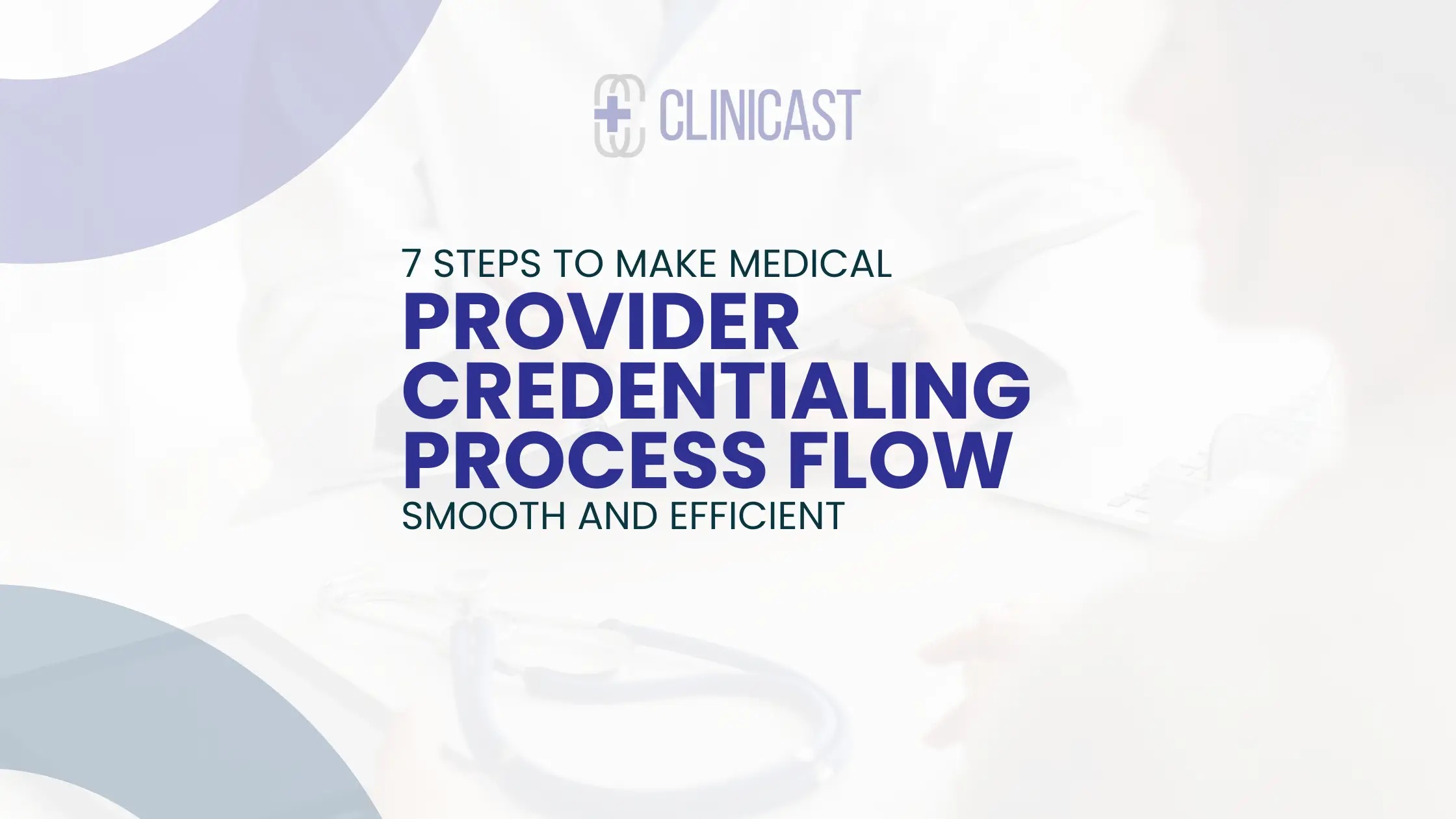The medical credentialing process is a procedure through which every physician, medical staff, paramedical staff, or technical section staff goes through. It is a mandatory process through which every hospital or medical facility makes sure its staff goes through.
The medical provider credentialing process flow of the staff members allows the medical facility to thoroughly verify the qualifications of the newly hired individuals, their skills as well as their previous job experiences, and registration with their provided insurance companies.
Even if a physician or a healthcare practitioner has been associated with any insurance company or panel in the past, whenever they apply for a new job they need to reapply their registration with the insurance company as well, this is also audited by the medical provider credentialing process.
The only drawback is that the medical provider credentialing process is very expensive and time-consuming and may occupy some of the resources of the hospital solely to perform this job. Therefore, to make it easier and transparent, here is a guide to help you make the provider credentialing process flow simplified and quick. Have a look!
Importance of medical provider credentialing process flow
The medical provider credentialing process is also known as the insurance credentialing process. A lot of medical facilities make sure that the newly hired individuals have provided authentic credentials, especially their insurance company registrations and claims. It is important for the hospitals to make sure all the staff undergoes the credentialing process so that their records are transparent and the board of directors has access to the details provided by the healthcare individuals.
The medical provider credentialing processes differ from facility to facility.
The credentialing process is immensely important to be conducted for:
- Hospitals
- Hospices
- Physical therapists
- Dentists
- Counselors
- Psychologists
- Licensed massage therapists
For a medical facility to work according to the rules and regulations of Medicaid and Medicare, it is important that the facility’s medical credentialing process is conducted to meet the guidelines provided by the federal agencies such as:
- The joint commission on accreditation of healthcare organizations
- Centers for Medicare & Medicaid Services (CMS)
Apart from the above-mentioned federal regulatory bodies, every state of the United States of America has its separate credentialing requirements as well which need to be fulfilled by the medical facility.
It is important for the medical practice to understand and follow the requirements of the state so that they can avoid the charges of malpractice later on.
As it is established now that medical provider credentialing is a lengthy, time-consuming process therefore we have come up with a few helpful steps that will make it easier to be conducted and save time simultaneously.
Let’s have a look:
1. Identification of documents
The medical provider credentialing process involves various kinds of forms and documents. You are supposed to submit all the documents along with the application to the insurance company you are planning to work with.
First of all, list down all the documents which are required. Some of the mandatory ones we have listed below for your ease:
- Name
- Demographic information (gender, ethnicity, languages, citizenship)
- Education
- Residency information
- Career history
- License proof
- Specialties
- History of previous claims
- Insurance proof
- Information about the medical facility applying for
The rest of the information can be collected from the application and the resume of the provider. However, you need to audit and investigate the information provided by the medical provider to ensure its accuracy.
2. Prioritizing the insurance company
It is immensely important to give priority to the insurance company. When you have to submit a number of applications then it is advantageous for you to prioritize the applications which you want to submit first, or which insurer you want to work with first, this will ease up your work as well.
- For instance, if a specific amount of your medical billing is delegated to a certain insurer, then it is advised to complete his application first.
- Always get familiar with the rules and regulations of the insurance companies. For instance, there are some companies that allow a flowing process for their medical providers who are already their clients whether they are in any other state, this makes the approvals easy and quick
- A lot of insurance companies give out abbreviated applications to their medical providers who are already their credentialing partners in the same state.
Once you have prioritized the insurance companies and the documents, you can start assembling the applications.
3. Accuracy of the information provided
Once you have started assembling the required documentation for the application, keep in mind the most important attribute of the medical credentialing process is the accuracy of the information filled out in the applications.
Before you submit the application, make sure that you have:
Conducted a thorough check on the background of the provider,
Have verified the educational information, certification, and licenses from reputable medical and healthcare organizations like;
- The Educational Commission for Foreign Medical Graduates Certification (ECFMG)
- The American Medical Association (AMA)
- The American Board of Medical Specialties
- Any previous sanction records from the Office of Inspector General (OIG)
- Reviewed the history of previous insurance claims, privileges, and credentialing.
If there is any kind of error in the documents or information submitted in the documents, this may lead to issues. For instance:
- If the dates and months of the employment of the medical provider are not aligned and are not verified with the previous employers, then the application will go into revision – delaying the approval process.
- The same goes for the phone numbers and contact details of the previous employers that are unreachable now, delaying the approval of the credentialing process.
- Omission of any kind of previous malpractice claims can also result in the disqualification of the application.
Once all the documents have been assembled and later on verified thoroughly, you have to present the applications to the leadership of the facility in order to determine that they conduct the scrutiny and verification under the medical provider credentialing process.
4. Completing the council for affordable quality healthcare (CAQH) process
There are a lot of healthcare and medical insurers that are looking for credible partners to apply for the credentialing through the council for affordable quality healthcare
You need to make sure of following the steps while filling out the application through CAQH.
- Once the facility has verified the information and filed the application with any insurance company, they will be given a number of CAQH along with an invitation message to apply directly.
- The CAQH will give an option to the provider to complete the application form either online or on paper. There are about 50 pages in a form and it is better to fill it up on a computer to keep up the efficiency.
- Any kind of incomplete or inaccurate information by the insurer or the application provider will result in the delay of approval from the CAQH.
- After the initial application has been submitted, you should be ready for a re-assessment. A re-attestation is mandatory because this will maintain insurance eligibility.
- You might have to attest to the information provided by the medical practitioner at least four to five times a year.
5. Verification timeline
Once the application is assembled and submitted from your end, all you need to do is wait for approval.
This wait can be lengthy as normally it takes about 90 days for the credentialing process to be completed. The experts advise giving about 150 days to the completion of the process realistically.
The medical provider credentialing process might take longer if there is some kind of discrepancy in the application or any kind of issue arises. This will lead to a delay in the approval of the application and will also ask the applicant to come and verify the information.
6. Follow up
Always ask for continuous and consistent follow-ups to get a timely response regarding the approval or rejection. You do not have to wait for months to hear back from the insurance company. Here is how to make your follow-ups consistently
- It is ideally recommended to cultivate a strong relationship with any person from the insurance company. This will help you in establishing a rapport with the executive assistants, leadership, and the other staff that will enable you to ensure that your application is approved within the given timeframe.
- Maximize the chances of responses by checking on the insurer by phone instead of an email as it makes the conversation on a more personal level.
- If your application is delayed because of incomplete information, then submit the application with the desired information after thorough verification of the documents once again, and that too within the given time so that you can have a positive outcome quickly without waiting for a long period of time.
7. Recertification
Once all the verification has been done, the provider will receive a response from the credentialing panel of the insurance company. However, this does not mean in any way that you have been credentialed for life.
Unfortunately, this is an ongoing process that keeps on coming back and you need to update it at regular intervals down the lane.
For instance,
- If by any chance you discover that there has been an error in any of the information provided by the employee, then you have to notify the insurance company. Sadly, if the insurance company notices the error on their own before you could send a notification for a correction then this might revoke your credentialing process.
- A lot of providers must go through the process of re-credentialing after every three years.
As mentioned above, the online credentialing system or the credentialing software helps immensely in managing the credentialing application process. The software also notifies you automatically when it is the right time to renew the credentials of any of the medical providers working in your medical facility.
On the other hand, the insurance company also sends out notifications to the said medical facility once the tenure of 3 years has passed and it is time to renew the credential application. It is important for you to respond within the timeframe to avoid any kind of hindrance in the approval of the recertification process and your facility or the medical provider working in your facility can continue to work and provide his services without any kind of interruption.
Payment contracts negotiations
Apart from the credentialing process, another grilling task on the hands of providers is to negotiate the financial contracts. The insurance companies continue to change the terms of payment and even the payment requisitions at regular intervals making it a painstaking task to upgrade all the documents and reach a favorable agreement with the insurers.
Sometimes the medical facilities outsource their negotiation process with the insurance company in order to save time as well as their prized resources for other important tasks such as credentialing, patient care, etc.
Even if the negotiation process is outsourced, the goal still remains the same and that is to reach an agreement that is favorable for the medical facility as well as the insurance company.
Final thoughts
The medical provider credentialing process is a lengthy process that is expensive at the same time. Still, it is very important to conduct it with honesty and extreme focus to avoid any kind of malpractice claim later on by the insurers and other regulatory bodies.



